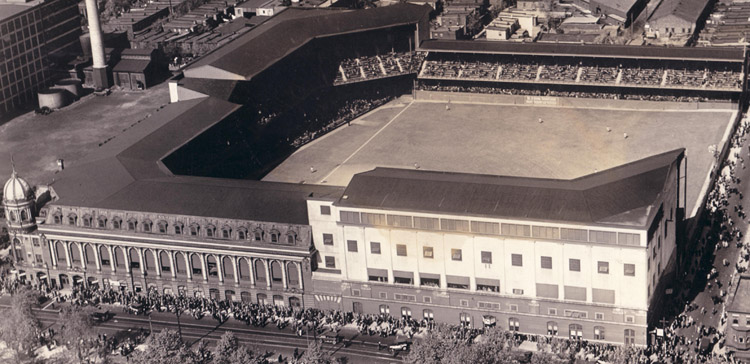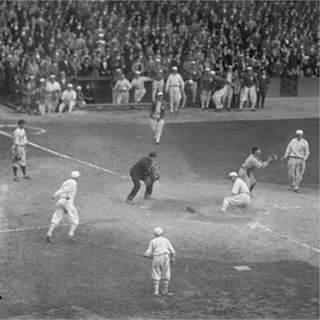|
Pivotal World Series Moments
Wilson Misplays Two Flies
1929 World Series Game 4: Chicago Cubs @ Philadelphia Athletics
Hack Wilson hardly looked like a major league baseball player. He stood only 5'6" tall. His legs were short, and he wore size 5 1/2 shoes on his tiny feet.
But he weighed 190 pounds with muscular arms and a huge, barrel torso. "He ain't got no neck," said John McGraw, who scouted Hack in the minor leagues and had him on his Giants roster in 1924 and 1925.
Although he lacked a "major league body," Wilson could hit. After being traded to the Cubs in August 1925, he led the National League in home runs three years in a row with 21 in 1926, 30 in '27, and 31 in '28.
He led the Cubs to the National League pennant in 1929 with 159 RBIs, 39 homers, and a .345 batting average.
The A's led Chicago two games to one, with the visiting team winning all three
games. The Cubs were on their way to tying the series with an 8-0 lead going
into the bottom of the seventh at Shibe Park. Charlie
Root was coasting with a three hitter.
66-year-old Connie Mack, A's manager, told several regulars to go to the clubhouse after the inning to give his benchwarmers a chance to play in the World Series.
Then the roof
fell in on the Cubs, aided by two misplays in centerfield.
 Shibe Park during the 1929 World Series

 L-R: Hack Wilson, Mule Haas slides home to complete inside-the-park homer. In the Philadelphia dugout, 3B Jimmy Dykes slapped the man next to him on the back and shouted, "We're back in the game, boys!"
Imagine Jimmy's chagrin when he realized he just knocked his manager off the bench. "I'm sorry," said Jimmy, pulling Mack to his feet. "That's all right, Jimmy," said Connie. "Everything's all right. Anything you do right now is all right. Wasn't it wonderful?"
 L-R: Jimmy Foxx, Mickey Cochrane, Al Simmons In what Cubs fans ever after called "the inning," Philadelphia scored 10 runs on nine hits, two of which were lost in the sun by Hack Wilson.
The 10-run inning has been matched once (by Detroit in 1968) but never bested in any World Series.
The A's held on 10-8 to take a 3-1 lead in games. Connie Mack's men won the Series the next day with three runs in the ninth, 3-2
Wilson came into the clubhouse sullen and angry. McCarthy tried to console his center fielder, but Hack brushed him aside. Joe told the press. "The poor kid simply lost the ball in the sun, and he didn't put the sun there."
Wilson left the locker room in a daze but brightened when he saw his four-year-old son. "Hello, Daddy," the boy said. Hack picked up his son, kissed and hugged him. Tears rolling down his cheeks, the crusty pro's body shook with emotion.
Reference: Two Spectacular Seasons, William B. Mead (1990)
|